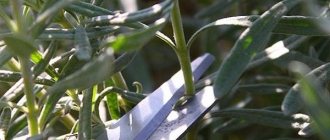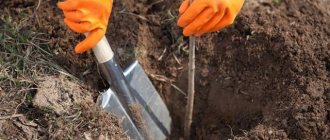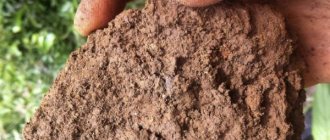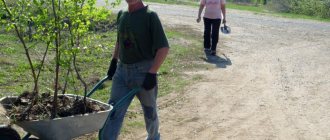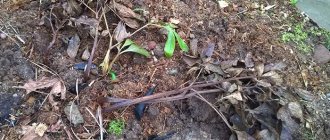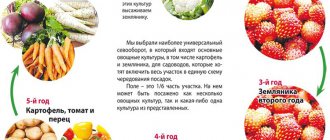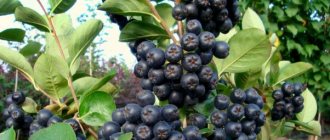How to care for apricots in the fall in order to properly prepare for winter: main autumn activities
So, here's what you need to do after harvesting your apricots to prepare the tree for winter:
- perform autumn fertilizing;
Important! In principle, all fruit trees are fertilized in the same way in the fall , so, for example, you can read this material about fertilizing an apple tree in the fall .
- trim;
Note! As a rule, apricots are pruned in the spring , which you can read about in detail in this article .
- clean the trunks of old dead bark, various mosses and lichens (if necessary);
- clean the tree trunk from plant and other debris;
Important! If the tree is not sick, then the garbage (except for fallen fruits) can be thrown onto the compost heap. But if it hurt, then it needs to either be burned, or buried very deeply, or simply taken out of the area.
- carry out eradication treatment;
- whiten (necessarily after processing).
Advice! Everything about whitewashing fruit trees (including apricots ) is described in detail here .
- carry out water-charging irrigation and dig up the soil in the tree trunk circle;
- cover for the winter (including protecting young trees from rodents, sunburn and damping off of the root collar).
Next, we will analyze each of the activities for autumn care of the apricot tree.
Insulation technique
Gardeners often mulch the soil using 20cm layers of sawdust, straw, humus or hay. Then it’s a good idea to wrap the root collar with material that allows air to pass through. With such insulation, the root neck of the trunk will not support. Otherwise, the tree will not survive the winter cold well, and there will be a crop failure. As for the northern regions, it is best to cover the tree completely. A film is thrown over it. Its ends are secured to stakes, which are covered with earth.
Young seedlings
Frail and young seedlings are covered especially carefully and efficiently. The root system of such apricot trees is still poorly developed. This means that in severe frosts it can freeze very much. Sometimes the young plant dies. The branches and trunk love warmth, so it is important to cover the plant with burlap or similar material.
Old plantings
If old apricot trees grow in the middle zone, there is no need to insulate them. In such cases, only mulch is used to protect the root system from frost and snow. Also, such a shelter is needed to drain excess water from the roots. As for the northern regions, both old and young trees provide shelter here. Before covering old plantings, they are cut to 2.4–2.5 m in height.
Autumn feeding of apricot after fruiting
Immediately after the apricot harvest, i.e. Even in the second half of summer, it is advisable to feed apricot trees with phosphorus-potassium fertilizers (in no case nitrogen fertilizers such as urea or ammonium nitrate).
If you did not do this in the summer, then, of course, you can and should fertilize in the fall, for example, in September.
Most often, superphosphate and potassium sulfate , or simply potassium monophosphate (it is more expensive, but also more effective), or they buy ready-made special “autumn” (=phosphorus-potassium) fertilizers for the garden. Naturally, there is also an organic analogue - wood ash (potassium) and bone meal ( phosphorus ).
Important! As a rule, all fruit trees are fertilized approximately the same in the fall , so, for example, you can read this detailed article about autumn fertilizing of an apple tree .
By the way! All stone fruit crops take a lot of calcium from the soil to build their seeds , so it is very advisable to periodically feed apricots with calcium fertilizers , for example, calcium nitrate, dolomite flour (it also deoxidizes the soil). Moreover, they can be applied at any time - both in autumn and spring.
Video: how to feed apricots in the fall
Foliar feeding for better ripening of shoots
If at the beginning of autumn you see that the shoots of a young apricot planted this spring are still completely green , i.e. unripe and non-lignified (and such shoots simply cannot overwinter and will definitely freeze), then to speed up their ripening ( they should turn brown in winter ), you must carry out foliar feeding (spray the solution on the leaf) with phosphorus-potassium fertilizer (optimally - monopotassium phosphate ).
By the way! Summer chasing or pruning is also used to ripen apricot shoots . So, the length of young growth should not exceed 40-60 cm, everything else needs to be trimmed.
Autumn pruning of apricot
As you know, it is better to prune all fruit trees, including apricots, in early spring. However, in some cases, autumn pruning is also allowed.
Advice! The site has detailed material on how to prune apricots in spring .
The fact is that in the fall the trees stop all active defense (their defense mechanisms stop), while millions of fungal spores fly around. In addition, when frost sets in, the cambium freezes over, making it difficult for the wound to heal. In other words, autumn pruning weakens all trees and their winter hardiness decreases. Therefore, it is believed that only winter-hardy species that can tolerate frost well and are not at all afraid of freezing can be pruned in the fall (apricot is definitely not one of them, since the crop is quite thermophilic).
There is also a common, but not indisputable rule that pome trees are pruned in the fall, and stone fruit trees in the spring.
In general, in the fall, most often only sanitary pruning of apricots is carried out , i.e. get rid of dry, broken and diseased branches (especially those affected by moniliosis, which have monilial burn ).
Apricot moniliosis
Autumn treatment of apricots against diseases and pests: eradicative spraying
So, by means of this treatment of the apricot tree, you need to eradicate all remaining pathogenic fungi and insect pests ( including their eggs) so that they cannot overwinter on/in the bark and trunk circle (in the soil) .
As for timing, autumn eradicating spraying of apricots is carried out only after all the foliage has fallen from the tree, the plant has completely gone into a dormant state , its buds have “closed” and become inaccessible to powerful and strong solutions (i.e. they will not burn) , with which we will spray the tree.
However, you shouldn’t delay it too much: it’s important to do it before the onset of stable frosts , otherwise the drugs (fungicides and insecticides) simply won’t work and the procedure will become pointless (as a rule, most products are effective at a temperature of +5, so read the instructions carefully).
with urea or Bordeaux mixture is most often used as a means for autumn treatment of trees .
You only need to process 1 time .
Video: autumn eradicating spraying of fruit trees
By the way! If in the summer you noticed that the leaves of your apricot trees have dried out, hanging as if “burnt”, then know this: this is a monilial burn (moniliosis) . with Bordeaux mixture or simply copper sulfate also helps against the disease (but they are better in the spring).
Video: how to spray apricots and cherries against moniliosis in the fall
Note! If you treated apricot in the fall, this does not mean that you no longer need to spray it in early spring Just as needed! Autumn eradicating spraying is actually similar to early spring garden treatment (the very first, it is also called eradicating) .
Preparatory work
Initially, gardeners and summer residents need to carry out preparatory work. To do this, you should fertilize the trees with phosphorus and potassium. It is also recommended to use a mixture consisting of crushed chalk and ash. The mass is classified as a mineral fertilizer that does not harm the plant.
Whitewashing is a stage that should also not be skipped when caring for apricots. By painting the trunk with a proven solution, summer residents eliminate the risk of insects breeding on the bark. As a rule, 2 kg of lime, 1 cup of paste and 200 g of copper sulfate are taken. The substances are mixed and tree trunks are whitened.
It is also important to properly prepare the crown of the plant. This contributes to the distribution of the flow of nutrients that occurs inside the tree. Thanks to proper pruning, the maximum amount of nutrients reaches the fertile branches.
In the fall, summer residents and gardeners carry out regulatory and formative pruning of apricot trees. If wounds remain after pruning or filing large branches, they are lubricated with copper sulfate, garden pitch or clay. All substances guarantee rapid healing of wounds on the trunk. If the putty falls off, but the wound does not heal, it is covered again.
Whitewashing apricots in autumn
The purpose of autumn whitewashing of any fruit trees (including apricots) is to prevent frost damage (sunburn) , cracks in the bark that form due to temperature changes (plus or minus, plus or minus) during the transitional winter-spring period (in February -March).
Note! Whitewashing in the spring (April-May) has no meaning other than aesthetic. It’s another matter if you come to your dacha at the end of February or beginning of March and whitewash it. But does anyone really do that?
Accordingly, old trees, and especially young ones, need to be whitewashed. Moreover, when whitewashing the trunks of young seedlings, you should use weaker solutions (if you use lime, then its concentration should be reduced by 2 times) so as not to burn the young bark. Or you can use special paints for whitewashing garden trees: buy the same water-based or water-dispersion paint, or acrylic.
In any case, it is necessary to whiten it, since young seedlings have the thinnest bark, which can very easily be damaged in late winter and early spring from sunburn (it will simply burst due to temperature differences).
By the way! The site already has an article about when and how to properly whiten fruit trees in the fall (all trees are whitened in the same way) .
By the way! There is a well-founded opinion that it is better not to bleach very young seedlings with smooth bark, but to wrap the trunk with white covering material (spunbond tapes) . In this way, you will not only prevent sunburn, but also protect the seedling from rodents (more on this in the next paragraph) .
Autumn moisture-charging irrigation
It is also called “moisture-recharging” irrigation or “winter” irrigation.
Autumn moisture-recharging watering of apricot is another useful measure that allows you to better prepare the tree for winter by “filling” it with moisture. The fact is that moist soil freezes less and has greater thermal conductivity, in other words, heat from the lower layers of the soil will warm the roots of your apricot tree during the cold period.
By the way! Moisture-charging irrigation is recommended for all fruit trees and berry bushes.
When?
- With the beginning or after leaf fall, on the eve of cold weather (at positive temperatures).
When is winter watering especially necessary?
- If you have sandy loam soil and autumn does not indulge in frequent and heavy rains, and the winter has little snow.
Worth understanding! Of course, if the fall is very rainy, then you can completely do without moisture-recharging irrigation.
How much water will be needed?
- Approximately 40-100 liters of water per 1 square meter of tree trunk circle (for young people - 40-50 liters, for adults - 80-100 liters), i.e. you need to calculate the area based on the projection of the crown (its perimeter). The more mature and massive your tree is, the more water will be required: approximately 50 to 200 liters.
Advice! Naturally, you don’t need to carry any buckets: take the hose and move it around the tree trunk (and first measure how many minutes it takes to fill one 10-liter bucket. For example, if it takes 30 seconds, then 5-10 minutes will be enough).
Video: what is moisture-charging irrigation and how to carry it out correctly
Advice! And after watering (for example, the next day), it is also very advisable to loosen the soil in the tree trunk circle, because loose soil freezes less.
Of course, if you have a good layer of turf under the trees or just grass (lawn) growing, then you don’t need to touch it.
How to keep the soil moist
Watering itself is important, but it is equally important to maintain moisture in the soil so that the roots never suffer from changes in humidity, which is the most painful for them.
Mulching is one of the main techniques for maintaining soil moisture. It is wisest to use a variety of organic matter as mulch, because... This will also serve as additional feeding. This category includes mulching with grass clippings, straw, compost, sawdust, etc.
Another way to retain soil moisture is to sow ground cover perennials with shallow roots. This method is advisable to use in the southern regions to save apricot roots from drying out.
